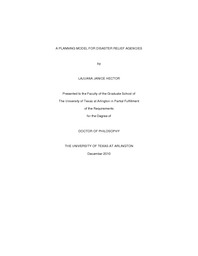
ATTENTION: The works hosted here are being migrated to a new repository that will consolidate resources, improve discoverability, and better show UTA's research impact on the global community. We will update authors as the migration progresses. Please see MavMatrix for more information.
Show simple item record
| dc.contributor.author | Hector, LaJuana Janice | en_US |
| dc.date.accessioned | 2011-03-03T21:52:52Z | |
| dc.date.available | 2011-03-03T21:52:52Z | |
| dc.date.issued | 2011-03-03 | |
| dc.date.submitted | January 2010 | en_US |
| dc.identifier.other | DISS-10880 | en_US |
| dc.identifier.uri | http://hdl.handle.net/10106/5497 | |
| dc.description.abstract | Rather than identify nongovernmental organizations (NGO) with traditional service delivery systems, NGOs should be viewed as a unique system with specific outcomes pertinent to resource distribution. Grounded theory was used to help design the research methodology and General Systems Theory (GST) served as the theoretical framework. Predisaster planning, training, and leadership results from the empirical research helped to identify perspectives of resource distribution. Open ended interview responses were analyzed using the open coding, content analysis, constant comparison methods which yielded management as the theme with coordination, communication, and preparation as sub-themes. While each outcome may be contingent upon each designated organization and individualized for each natural disaster, a model designed for NGOs can serve as a template for more efficient resource delivery to disaster victims. | en_US |
| dc.description.sponsorship | Rycraft, Joan | en_US |
| dc.language.iso | en | en_US |
| dc.publisher | Social Work | en_US |
| dc.title | A Planning Model For Disaster Relief Agencies | en_US |
| dc.type | Ph.D. | en_US |
| dc.contributor.committeeChair | Rycraft, Joan | en_US |
| dc.degree.department | Social Work | en_US |
| dc.degree.discipline | Social Work | en_US |
| dc.degree.grantor | University of Texas at Arlington | en_US |
| dc.degree.level | doctoral | en_US |
| dc.degree.name | Ph.D. | en_US |
Files in this item
- Name:
- Hector_uta_2502D_10880.pdf
- Size:
- 641.1Kb
- Format:
- PDF
This item appears in the following Collection(s)
Show simple item record


